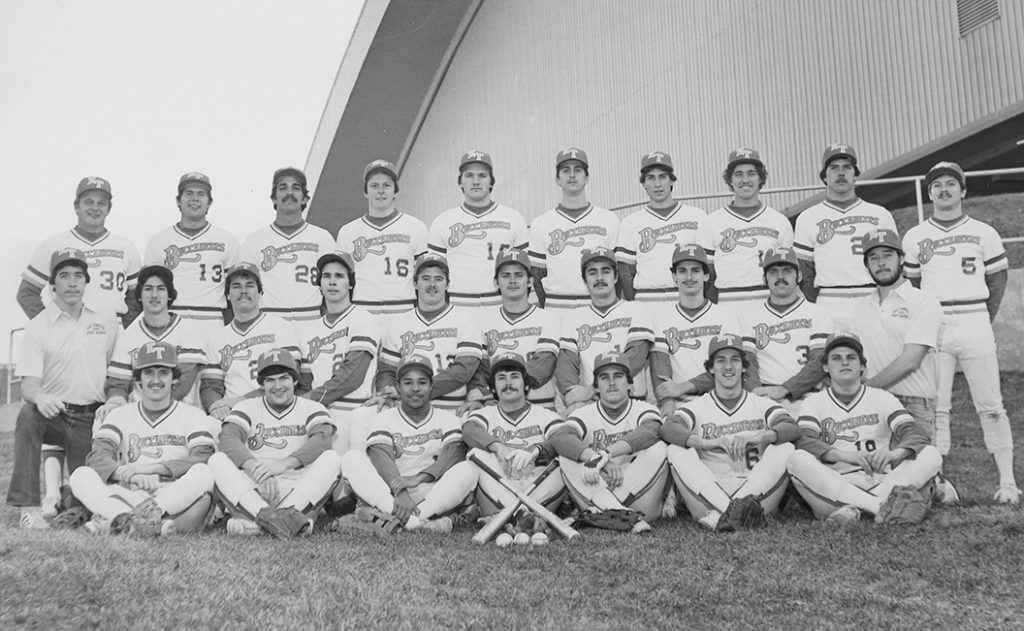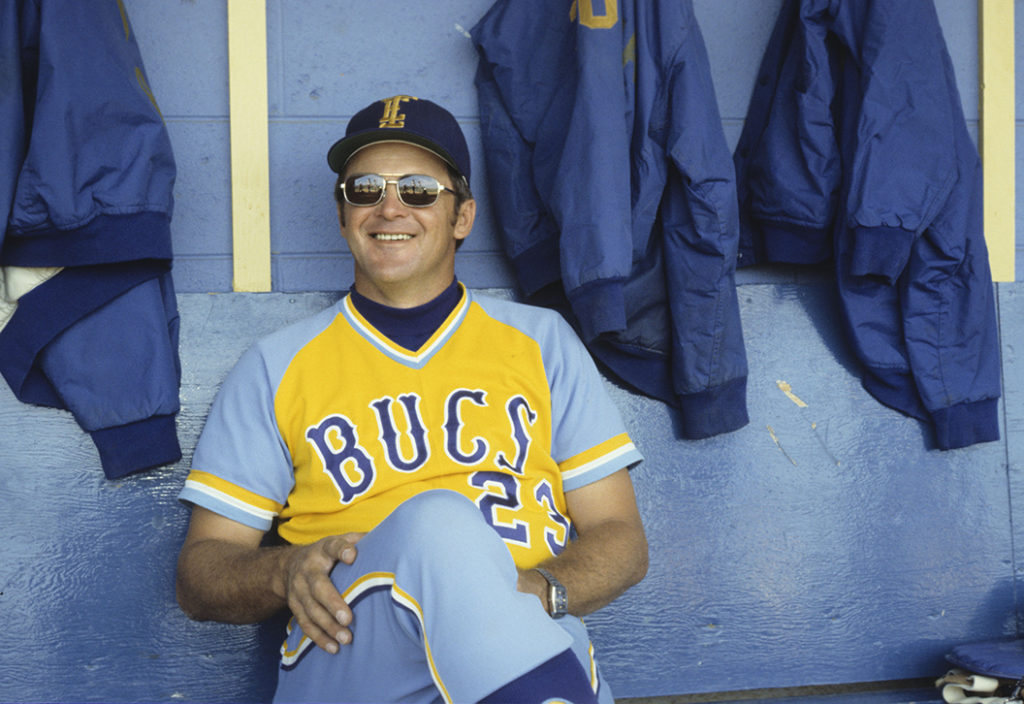
By Trey Williams
East Tennessee State University baseball was essentially a glorified intramurals program when fast-talking Charley Lodes arrived in 1977 after managing Temple (Texas) Junior College to national prominence.
Joe Shipley, Lodes’ predecessor, hadn’t won more than seven games in a season for five straight years when Lodes took the wheel. And yet, this swashbuckling new skipper propelled the “Battlin’ Bucs” to an Ohio Valley Conference championship during his first season in 1978.
ETSU went to three NCAA regional tournaments in Lodes’ six seasons and defeated the likes of Wichita State (Joe Carter) and Clemson (Jimmy Key) after getting there.
Lodes wasn’t limited to the audacity of dreams. He had an enthusiastic new president in his corner in Arthur DeRosier, who Lodes fondly recalled giving him a green light almost from the get-go.
“The president said, ‘You’ve got 19 returning players and there’s not a damn one of them that can play,’” Lodes said in May of 2013, some 15 months before he died at the age of 72 in Oklahoma City. “So (assistant coach) John Whited and I went around to all the frat houses just trying to find enough people that we felt like would not embarrass us, at least. And of that 19, after the first week we had nine left. And they had made a commitment to take this club to places where it’d never been before.”
Lodes’ first recruit was actually a baseball letterman. Basketball player Atlee Hammaker, who went on to a successful Major League Baseball career, had played for Shipley as a freshman in ’77. He said he played as a favor to basketball coach Sonny Smith because baseball money had been used during Hammaker’s recruitment.
“I had no plans on playing further than that,” Hammaker said, “and Charley Lodes came in my sophomore year and pretty much begged me almost every day after basketball practice while they were working out in the cage. The cage was in the Mini-dome. It was right next to the track there. So I’d come off the basketball court and he’d always come over and say, ‘I’d love for you to come over and throw a few minutes for me’ and ‘I’ve heard a lot about you’ and all this stuff. So anyway, over a period of time, with enough nagging, I went over there and threw on the sideline for him.
“And that’s when he said, ‘You’re crazy if you don’t quit basketball and play baseball.’ And so I said, ‘I don’t plan on quitting basketball,’ but that was encouraging on his part. … Charley believed in me greatly. That’s the one that gave me the inspiration to keep going. He said, ‘You’re a big-league pitcher.’
“At first I thought, ‘Man, this guy’s just trying to get me to play.’ … It made a huge difference in my sight, for sure. I owe a lot to him.”

Hammaker-led ETSU made its first trip to the NCAA Regional in Lodes’ first season in ’78 and returned to the regionals in 1980 and 1981. The Buccaneers were ranked No. 22 in 1980 and No. 17 in ’81.
The ’81 team was a win away from the Super Regional thanks to wins against Wichita State (Joe Carter, Phil Stephenson) and Clemson (Jimmy Key).
Lodes brought in players such as Wayne Dannenberg, Joe Graves, Bryan Snyder, Mike Nipper, Jeff Andrews and B.J. Swinson. He strongly suggested to some of the recruits that a trip to Hawaii would be in the cards if they became Buccaneers.
“My group was the Hawaii group – Nipper, Dannenberg, Tim Bailey,” said Phil Pierce, who signed with ETSU out of Elizabethton and started on the mound when the Bucs beat mighty Wichita State. “Charley was a salesman. He would’ve made a million dollars if he’d went into sales.”
Lodes convinced Top 25 programs to visit the Tri-Cities – at a time when ETSU’s home field was Mooney Field, which was often referred to as a swamp with a few colorful words. But the premier visitors generally played at Cardinal Park – or even a minor league park in Kingsport or Bristol on occasion.
“When I interviewed for the job I wasn’t gonna come,” Lodes said. “They asked me, ‘What do we need to do to be competitive?’ I said, ‘The first thing you need to do is fly over the fields here and drop a bomb and get a good field.’ …
“We had five games, I think, at Cardinal Park, when we played Tennessee and Virginia Tech, uh, Clemson. When we played the top teams we filled up Cardinal Park, and the other times we played at Mooney Field.”
Pitcher Jeff Andrews was Lodes’ first recruit. He went to three regionals in four years.
“That was quite an era when Charley was there,” Andrews said. “I think probably the biggest one was in ’78 when we won the OVC playoff. We didn’t show very well. We got beat by Memphis State and North Carolina and got eliminated, but I think it kind of started the ball rolling.
“What was strange was probably our best team was my sophomore year (’79) when we didn’t make it. We had Atlee and a really nice team. That might’ve been our best team. My third year we ended up winning 26 games in a row, and made it to the regional down in Clemson. So it was quite a fun time for baseball at ETSU.”
Lodes was a man’s man and a players’ coach, a short-fused visionary who chewed out umpires, dipped Copenhagen and spit blood.
“We were down in New Orleans and Charley was pitching BP and Bryan Snyder hit a line-drive that barely nicks the screen and hit Charley in the face,” Pierce said. “It knocked out his two front teeth or maybe he was wearing dentures. Whatever it was he picked them up and put them in his pocket. I mean, he’s out there spitting blood everywhere and he’s dipping that Copenhagen, and he put his teeth in his pocket and kept pitching BP.”
Baseball apparently led to dentures or a partial at some point.
“I remember him taking his teeth out in the shower one day and just about everybody fell on the ground,” Andrews said. “He was just on the verge of full throttle with everything he did. And it was just hold on and jump in and follow him, because you knew he was never gonna be intimidated by any other team … or any other umpire. He always believed in you. He always thought that we could do it. And you just rode his wave.”
Thirty years later, Lodes lamented his program’s budget cuts shortly after DeRosier was replaced by Ron Beller.
“Charley took that really hard – how that went,” Nipper said. “And for him to hang in two more years – he stuck it out with us. We were young and playing baseball, but I think it wore on him hard, because he had so many dreams for that program.
“Charley had to work extra hard for me. I was hardheaded. We both were hotheaded. My first year, I thought my name was Dammit Nipper. I think I led the league in home runs and errors. They moved me from shortstop to third base right before we went to regionals. I’d started at shortstop all year. I didn’t make any errors at third base and Chris Hurst didn’t make any at shortstop.”
In several conversations this century, Lodes’ mind always eventually drifted
to what might’ve been.
“Three out of the six years I was there we went to the NCAA regionals,” Lodes said. “It’s a lot of fun when you bring the talent level in and teach them how to play the game. That’s what it’s all about. We had great speed in the outfield, and we had great speed overall.
“Atlee was probably the best player. He went the farthest. But plenty of the others signed contracts professionally. I think we had 12 or 13 playing professional ball. We went a long way in a hurry and – then it was over.”



